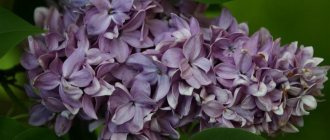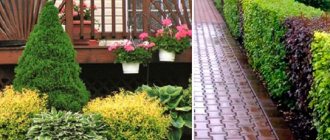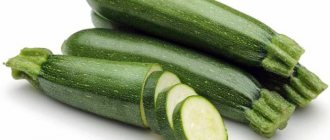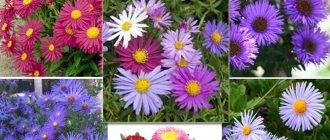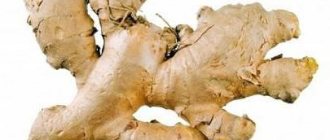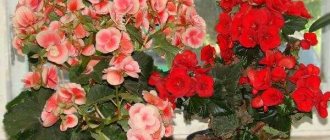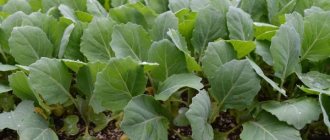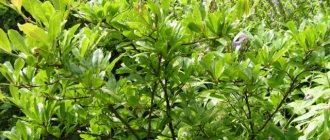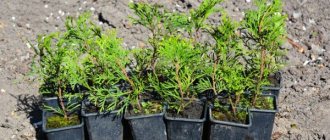Everblooming begonia
Another name is always-blooming begonia. It got its name for its ability to bloom year-round. It has been known in culture for a very long time, since about 1821. The leaves can be either green or bronze in color. Requires a large amount of sunlight for successful development. There are dwarf and tall forms.
Advantages:
- Continuous flowering.
- Unpretentiousness.
- Thanks to the evenness of the bushes, it is an ideal crop for landscaping.
We recommend reading: how to care for Stapelia?
Begonia everblooming
Begonia everblooming and its types
Baby Wing
"Baby's Wing" is a large bushy plant with green leaves and single and bicolor flowers of varying colors. This variety series is represented by large and strong bushes, has green and bronze leaves, monochromatic and bicolor flowers of various shades. A rather unique species that attracts most gardeners and florists with its unique leaf shape.
Ambassador
Begonia evergreen (ambassador mix) has become one of the most popular plants for flower gardens recently, although it was originally an indoor plant. This success was facilitated both by begonia’s own qualities and by the intensive work of breeders, which made it possible to create a wide variety of forms, varieties and hybrids. This is an early begonia with green leaves 20-25 cm high.
The plants are fast-growing, perennial, but are mainly grown as annual houseplants. The bushes are quite compact. The leaves are shiny green, the flowers are large (3 cm in diameter), located just above the leaves. A large palette of bright colors, very early flowering (blooms 10-11 weeks after germination) attracts many breeders.
This type can be in the following colors: Bicolor (white with pink edge), Coral (coral), Pink (pale pink), Rose (hot pink), Rose Blush (pink blush), Scarlet (bright red), White ( white).
This begonia reproduces well by various types of vegetative propagation - cuttings, leaves, division, and by seed.
Gloire de Lorraine
Lorrain - a hybrid of Begonia socotrana and B.dregei - is a uniquely beautiful hanging plant for moderately warm rooms. Its thin shoots, drooping with age, reach 50-60 cm and are covered almost all year round with a mass of rather large pink flowers with numerous yellow stamens. The flowers are dioecious, the female flowers are larger, with a triangular ovary. Seeds, as a rule, are not formed.
The flowering period of this plant is from November to March, and the color is very abundant, a large number of buds are collected in inflorescences. (If the plant does not bloom, read our article) A well-lit place is suitable for placing this indoor plant, but keep in mind that direct sunlight leaves cause burns, so this arrangement must be avoided, otherwise the plant may die. Blooming begonias, their photos with names are presented below.
Similar articles:
Review of the most popular indoor plants with…
Description of popular types of aloe with photographs
Mallorca pelargonium - a detailed description of popular...
Begonia tuberous
This type of begonia has a large number of varieties, differing in flower shape and leaf color. According to the shape of the bush, they are divided into bush and hanging. A distinctive feature of this species is the presence of a tuber.
Advantages:
- Can be grown in shady places.
- A huge number of varieties.
- Abundant and long flowering.
The disadvantage we can highlight is that tuberous begonias have a pronounced dormant period.
Begonia tuberous bush
Tuberous varieties
Looking at the flowers of these begonias, you can’t help but think that they are close relatives of camellia, carnation or rose - the similarity is so great. Their heart-shaped leaves are usually colored in various shades of green. These flowers bloom for the longest time, from May to mid-autumn.
Begonia ampelous
Representatives of this variety are distinguished by long stems, cascading and decorated with numerous bright flowers. Most often they are grown in hanging pots, creating an original floral decor on the balcony. The varieties of this group with double flowers are especially popular - “Roxana” (orange color) and “Christie” (snow-white buds).
Bolivian begonia
In this plant, shoots up to 30 cm grow straight, and then form cascades in several tiers of beautiful inflorescences. "Santa Cruz Sunset" attracts the eye with flowers in red and orange shades. "Copacabana" is a creeping plant that attracts with colorful bell-shaped flowers, usually red in color.
Bouton de Rose
This variety is characterized by small compact bushes decorated with large snow-white double flowers. The beautiful pink edging around the edges gives them special beauty. The petals are gathered in the center to resemble a rosebud, which is what gave them their name.
Crispa Marghinata
This tuberous begonia in the garden is a gardener's favorite. Beautiful bushes with green leaves with a purple border can be grown both in a flowerbed and in flowerpots in the house. During the flowering period, this variety pleases with colorful lush white or yellow flowers with a pink or red border, which have a light sweet aroma.
Fimbriata pink
The lush flowers of a soft pink hue of this variety are very reminiscent of carnations. The flowers have a pleasant fragrant aroma, which is very rare for the tuberous varieties of this plant. Fimbriata pink looks great in hanging flowerpots on balconies. You can plant begonia of this species in open ground. But it is worth remembering that this plant is very fragile and must be protected from the winds.
Belleconia
This terry begonia is classified as a root variety in most catalogs and is considered one of the most attractive among them. Long shoots are crowned with beautiful large flowers, which can be of different colors. The most impressive varieties of this variety are those with bright red, scarlet, peach and pink flowers. Belleconia is an outdoor begonia. It is most often grown indoors, but it grows better outdoors. Therefore, it is recommended to replant the plant in open ground as soon as it gets warmer.
4
Begonia tiger
Refers to decorative foliage forms. Valued by flower growers for its very beautiful brightly colored leaves. It got its name from the characteristic pattern on the leaves. Requires diffused lighting for successful growth.
Advantages:
- Unpretentiousness.
- Attractive appearance.
- Compactness.
Begonia tiger
Types of begonias
These indoor plants can be either annuals or perennials. The bushes can grow to a height of more than two meters and at the same time have very small flowers. Begonia root, on the contrary, is capable of producing inflorescences measuring more than twenty centimeters. Plants with unusually colored leaves and inconspicuous flowers that appear once a year are decorative deciduous, while the rest belong to the group of beautifully flowering plants.
We will look at the varieties of begonia, their photos with names below. Here are some beneficial properties of begonia:
- Active absorption of harmful chemicals, thanks to which the air in the room is quickly purified.
- Air humidification.
- Elimination of electromagnetic radiation.
- Contains a significant amount of useful substances (organic acids and tannins), which have antiallergic and antiseptic properties, and therefore can be used in folk medicine.
Many species have gone through so many selective changes that they have lost their original appearance. But this only made them more beautiful, more adapted to apartment living conditions.
Red leaf begonia (Pista)
Has the second name Fista. The underside of its leaf blades is painted red or burgundy, which is why it received the name red-leaved. The height of adult plants does not exceed 25 cm.
Advantages:
- Does not require maintenance. It can develop successfully even under artificial light.
- Spectacular appearance.
- Small plant size.
Flowering Red Leaf Begonia (Pista)
Everblooming (Semperflorens)
These include the most popular species and varieties of begonias with compact stems, round leaves, as if covered with wax, and numerous small flowers of different shades. They can be grown not only at home, but also in the southern regions - in open ground. Their leaves are glossy, green and red in color. At home they bloom all year round. The ideal place for them is window sills in western or eastern directions, heated glazed loggias, greenhouses, greenhouses. Here are some varieties of ever-blooming begonia that gardeners love:
Stara F1
This begonia is up to 40-50 cm high. The leaves are dark with a reddish tint, the flowers are white or pink.
Lotto F1
The bush reaches a height of 35-50 cm. It has large, bright green leaves and flowers - white, pale pink, crimson or red.
Ambassador F1
This name combines hybrids of medium-sized (20-25 cm in height) representatives of ever-flowering begonias of seven shades of flowers.
Eureka F1
The bush is a dwarf species and grows up to 15 cm in height. Its leaves are bronze-red in color. The flowers are scarlet.
Queen F1
The average height of the bushes of this variety of begonia is from 15 to 20 cm, the leaves are small and brownish. The flowers are double, pink with different shades.
Cocktail F1
Low bushes up to 15 cm. They have red-brown leaves and flowers of all shades of white, red and pink.
Royal Begonia (Rex)
Royal begonia or otherwise Rex is a decorative deciduous species. Successful growth requires bright but diffused light. Requires high air humidity. There are many varieties of begonias of this species with leaves of a wide variety of colors.
Advantages:
- Very decorative appearance.
- Large selection of colors.
- Not demanding on growing conditions.
Varieties of Begonia Rex (Royal Begonia)
How to care for begonia at home
Basic elements of caring for home begonias:
- watering;
- shading from direct sunlight;
- fertilizing;
- protection from drafts and temperature changes;
- transfer.
Lighting
Indoor begonias love consistency. To grow them, it is recommended to choose a place where the flower pot will stand all the time. The optimal light regime for plants is 12 hours, with soft lighting in the morning (from 8 to 11) and in the evening (from 18 to 20). In the midday heat of summer, flowers need shading (white cloth, thin paper, blinds). Direct sunlight burns the foliage of flowers.
From November to February, flowers need to be illuminated with fluorescent lamps. The ideal place for flowering crop species is the east, west, northwest or northeast side of the house. Deciduous species, especially those with white, silver, and red spots, prefer to “live” on southern windowsills.
Conditions for growing begonias at home
Temperature
Comfortable temperature conditions for most indoor begonias: +22...25˚C in summer and +15...18˚C in winter. Varieties of tropical origin (Spotted, Royal, Metallica, Ringed) prefer t +18...23˚C. Subtropical species (Yellow, Diadema) grow well at t +13...18˚C.
Watering
In summer, it is recommended to water the crop frequently and abundantly - once every 2-3 days, in winter - as the soil dries out (about 1 ruble/7 days). For the procedure, settled or cooled boiled water is used. If the air temperature is high and humidity is low, the soil is moistened daily. Watering is carried out at the root or by immersing the pot in a pan of water for 15–20 minutes. Tuberous varieties are at a dormant stage in winter; they do not need to be watered at this time.
Humidity
House begonias grow well at air humidity of 50–60%. You cannot spray plants with a spray bottle. Only the Elatior Balladin species is normal for this procedure. The deciduous part of the remaining begonias suffers from spraying. After water gets in, brown spots form on the leaf blades, the foliage falls off, and the above-ground part of the crop dies. Ways to maintain optimal moisture levels:
- humidifier;
- a tray with wet expanded clay, peat or moss in which to place a flower pot;
- containers of water placed next to the plants.
Top dressing
Decorative deciduous varieties can be fertilized with nitrogen-containing compounds during watering every 14 days from early spring to late summer. Fertilizing inhibits the formation of buds and promotes the growth of green mass. For these varieties, Agricola is suitable: the consumption rate is 1.5–2 g/1 l of water.
Flowering varieties of domestic begonias are fertilized with:
- At the beginning of the budding period, use liquid complex fertilizers. For example, Kemira Lux. Consumption of the drug – 0.5 tbsp. l. / 5 l of water. The frequency of fertilizing is once every 2 weeks during watering.
- During the formation of ovaries and during flowering - phosphorus-potassium fertilizers. For example, Bud. Consumption of the drug – 1 ml/1 l of warm water. The frequency of fertilizing is once every 2 weeks during watering.
Transfer
Tuberous varieties are replanted annually in early spring. Varieties with fibrous and branched roots - when the pot becomes small. How to replant home begonia:
- The next day after watering, remove the plant from the container and shake off the soil.
- Dip the roots for 10 minutes in a light pink solution of potassium permanganate.
- Rinse the root system with warm water.
- Use a sharp knife to trim damaged, diseased and rotten roots.
- Sprinkle the cut areas with crushed activated charcoal or charcoal.
- Fill a new, larger pot with a soil mixture of peat, sand, black soil and garden soil (ratio 1:1:1:2).
- Lower the plant, straighten the roots, add soil.
- Water the flower.
Ampelous begonia
Another variety of tuberous begonia. It has flexible flowing shoots, the length of which can reach 40 cm. It is grown mainly in hanging baskets or pots on a leg.
Advantages:
- Very abundant and long flowering.
- Requires a minimum of care.
- Spectacular appearance. Thanks to its long shoots it forms a flower cascade.
Ampelous begonia
Begonia Elatior
An artificially bred hybrid species obtained from crossing tuberous and Socotrans begonias. It is a beautiful flowering perennial plant. The height of the bushes does not exceed 40 cm. For successful growth and abundant flowering, it requires compliance with certain care conditions.
Advantages:
- Very abundant and long flowering.
- It has a very varied flower color.
- Flowering occurs in autumn-winter, when most other plants are dormant.
Begonia Elatior
Popular types and varieties of begonias with photos
Many types of begonia have emerged thanks to the efforts of breeders, and the number of its varieties continues to increase every year. It is quite difficult to understand all the varieties and study them in detail; it would take a lot of time. But it’s not difficult to navigate the main ones, the most common and popular ones.
Begonia Bauer
The unusual shape and color of the leaves attracts attention; for the unusual properties of this begonia variety, it is popular among amateur gardeners.
It grows as a small bush, the height of which, as a rule, does not exceed 30 cm. The spotted pattern on the leaves can be of different colors - from light green with dark veins to reddish-brown and even burgundy. This depends on the brightness of the lighting in which Begonia Bauer grows.
This type of plant was bred more than 40 years ago and has another name - Tiger.
This variety blooms with small white flowers that rise above the bush at a height of 10-15 cm. Tiger Begonia does not like high temperatures and feels comfortable in high air humidity. The optimal place for placing a pot with a flower will be partial shade - the windowsill of a western or eastern window. In bright sunshine its color will fade.
Begonia hogweed
Long dense pink stems and palmate, deeply cut leaves with clearly visible light veins are the distinctive features of this variety
Begonia hogweed got its name because of the shape and size of the leaves, which are similar to the leaves of the common hogweed in Europe. This variety grows wild in the warm and humid subtropics of South America. To grow it at home, it is necessary to provide the same warm conditions with high air humidity. At the same time, it is not recommended to spray the flower from above onto the foliage, as this can lead to stains on their surface.
Flowering of hogweed begonia begins in late spring. Small buds bloom on long stalks, which can be of various colors from pure white to pink. If there are too many flowers, this will affect the condition of the foliage, since the plant will not have enough strength to nourish both. Therefore, it is better to remove excess shoots with buds.
Begonia Griffin
The large decorative leaves of this variety will not leave anyone indifferent; they have the shape of a huge griffin's paw.
Begonia Griffin is a variety that was bred from another type of plant - the royal begonia. The noticeable leaves of this variety, different from many others, make it clear what kind of plant it is. The leaves are dark green in color and decorated with silver veins. At home, this is a perennial plant that grows and develops well in a lighted place and with regular watering.
The bush can reach 40 cm in height if it is periodically transplanted into a large container.
In the open ground in the garden or in a flower bed, griffin begonia is an annual crop. An important feature of this plant variety is its resistance to external adverse factors. Good lighting will contribute to the full development of foliage color, and regular moderate watering will ensure active, healthy growth of the bush.
Royal begonia
One of the most common and favorite begonia varieties among flower growers, which is distinguished by its unusual appearance and all kinds of foliage colors.
The peculiarity of royal begonia leaves is not only the variety of shades from brown-pink to greenish-purple and even purple. In addition, they are decorated with a silver or white border, which overall creates an amazing impression when contemplating this miracle of nature. That is why royal begonia is one of the most popular varieties grown at home.
Royal begonia is not demanding in terms of care. Air temperature 20-24 degrees, watering with settled water at room temperature - once a week. It is important to place the pot with the plant in a well-lit place - the windowsill of an east or south window. In partial shade, the leaves of the flower will begin to fade.
Begonia metallic
Another variety of decorative deciduous plant, which is distinguished by asymmetrically oblong leaves that have a light olive color. In good light they have a metallic tint.
Despite the fact that this variety of begonia belongs to the decorative deciduous variety, in the summer it blooms profusely and luxuriantly with large pink buds. The unusual and bright combination of light green leaves with voluminous crimson flowers is a beautiful sight. For this appearance, many gardeners love metallic begonia and are happy to grow it at home.
In order for a plant of this variety to feel comfortable in a pot, it is necessary to provide suitable environmental conditions. The flower gets used to a certain temperature regime and reacts sharply to its change. Therefore, it is advisable to maintain the thermometer reading at 22-24. Water at least once a week. Provide a good level of air humidity, but do not spray the leaves of the plant - this may cause them to become dull or stained.
Begonia Cleopatra
Begonia cleopatra is a truly home plant that grows in the form of a small bush up to 30-40 cm in height and feels great in the limited space of a pot.
A distinctive feature of this variety is its leaves, which are reminiscent of maple leaves in shape and color. They are formed on a rather long stalk, which is covered with thick white or grayish fibers. The leaves themselves are two-colored: the outer side is dark green, while the bottom is reddish-brown.
Begonia cleopatra blooms in autumn and winter. Under favorable conditions, the plant produces several flower stalks on long stalks. Small white and pink buds bloom at the top of the peduncle. In order for begonia to develop properly and grow actively at home, it needs to be provided with diffused light, maintain a stable temperature of 18-22 degrees and regularly moisten the soil.
Begonia snail
The unusual shape of the leaves is the main feature of this variety; they twist into a bizarre spiral, reminiscent of a snail's shell.
The leaves of the begonia variety snail are dark green in color and have silver veins. The bush is formed by the growth of one leaves on another, since this is one of the few plant species that has short cuttings.
The result is a fairly dense bush, the height of which at home does not exceed 30-40 cm.
To preserve the unusual color of the leaves, it is better to keep begonia in a well-lit place. Water with settled water at room temperature and make sure that moisture does not get on the foliage - only in the soil.
Begonia Ambassador
The flowering variety of begonia is one of the most attractive due to its abundant flowering and variety of shades.
Despite the fact that the main advantage and distinctive feature of the Ambassador variety is its bright flowers, its leaves also have a bizarre shape and color. Small in size, round, uniformly green in color, but with a thin red border around the edges. The colors of the buds amaze the imagination with their diversity: from snow-white and soft pink to bright red, scarlet, crimson and even lilac.
Begonia Ambassador loves good lighting, but it is better to shade it from direct sunlight. The optimal location for the pot at home is the southeast or southwest side. With insufficient lighting, begonia loses its brightness and color saturation.
To extend the flowering period in winter, you can install additional lighting.
Begonia boliviana
Blooming Bolivian begonia is a type of hanging plant - long soft branches and peduncles fall down beautifully, so it is best to plant it in a pot that can be hung
This variety is one of the few plant species that can easily tolerate high temperatures and prolonged drought. This does not mean that the Bolivian begonia does not need to be watered at all, but it is unpretentious in terms of care. Back in 1984, an English botanist was in Bolivia and discovered this amazing flower, brought it with him to England and presented it at a flower exhibition. Since then, the popularity of Bolivian begonia has been constantly growing.
This plant variety is distinguished by elongated small dark green leaves. Unlike many other types of flowers, they have a uniform color, and the veins practically do not stand out on their surface. Many other varieties have been bred from Bolivian begonia, but they all have one similar feature - small elongated inflorescences of various colors.
Begonia Crispa Marginata
A luxurious variety with unusual flowering, growing equally well both at home and in a garden flower bed.
Begonia variety Crispa Marginata is a tuberous plant. As a rule, this is a small bush, the height of which does not exceed 40 cm, both in open ground and in a pot at home. The small green leaves are round in shape and edged with a thin purple stripe. But the flowers of this variety are strikingly different from many other species.
In appearance, they are similar to carnations - multi-layered, curly and combine several shades.
They can be of different colors from soft white to pink and even orange. The very name of this variety is translated as Bordered Curly, so it fully corresponds to its appearance.
Begonia Crispa Marginata prefers a cool climate: in summer it is undesirable for the temperature to rise above 22 degrees, and in winter the optimal conditions for it are 14-16 degrees. Weak partial shade or diffused light is best suited for active growth and flowering of begonias. In addition, the plant needs regular watering and fertilizing.
Begonia Bud de Rose
This small compact bush reaches a height of no more than 20-25 cm, has beautiful
Another spectacular type of decorative flowering begonia, characterized by large lush buds reminiscent of roses. Begonia Bud de Rose is a popular greenhouse plant that attracts with its appearance. It is also possible to grow it at home, like many other varieties, although it grows best in open ground.
Landscape designers often use the beauty and unusual appearance of Bouton de Rose to design alpine slides, rockeries and border strips.
When planting begonia in open ground, you need to try to find a place that will be well lit, but will allow you to avoid direct sunlight for most of the day. Regular watering and weeding will promote active growth and flowering of the Bud de Rose. For the winter, the tubers need to be dug up and stored in a cool, dark place.
Begonia Mason
It got its name from the botanist who discovered this species. In everyday life it is often called the “Maltese cross” or “deer antlers”. The leaves have a characteristic pattern resembling a cross in shape. Plant height does not exceed 30 cm.
Advantages:
- Can be grown under artificial light.
- It is unpretentious and does not require any special care.
- Spectacular appearance.
Begonia Mason
Begonia propagation
This process can be carried out in three ways:
- seeds
- cuttings
- dividing the tuber
The first method is almost never used due to its labor intensity, so begonia propagation at home is most often carried out by vegetative methods.
Propagation by cuttings
For this purpose, cuttings from stems or leaves are prepared; The optimal time for cutting cuttings is early May. It is best to use whole leaves as cuttings. The prepared cuttings are installed in a substrate of peat-sand mixture. Sometimes cuttings are germinated in water before being placed in the substrate.
It would be a good idea to treat the cut of the cutting with any rooting agent. Watering the cuttings should not be too frequent - approximately once every 7 days. More frequent watering leads to rotting of the cuttings.
After about a month, the cuttings take root and can be transplanted into a separate pot.
Stem cutting
Reproduction by tuber division
This is the main method of propagating begonias when caring for them at home. In this case, young tubers are used, which should be germinated for no more than 1 week before dividing (until the first shoots appear).
Division is done by cutting the tuber into pieces with a knife, so that each part of the tuber has a sprout and a root. The cut site is treated with charcoal or sulfur. After this, the tubers are placed in a substrate (preferably pure peat), but they are buried at about half the depth.
Separating begonia tubers
Begonia Griffin
It is a new hybrid species obtained from royal begonia. It differs from its parent in having larger leaves. The height of the plant is about 40 cm. It is less demanding on air humidity compared to royal begonias. In winter, begonia can be grown as a houseplant, and in summer it is suitable for use as a container crop in the garden.
Interesting information: how to care for Beloperone?
Advantages:
- Very exotic appearance.
- Universal use.
- Unpretentiousness.
Begonia Griffin
Problems with the plant
Begonia itself is a rather whimsical plant that requires careful care. Some simple begonia problems can be solved by paying close attention to the plant's appearance:
The presence of medium-sized brown spots on the leaves indicates that the plant has received burns and requires urgent transfer to a shaded area. If, after moving the plant into the shade, these spots do not go away, then the plant needs to be fed or the watering regime changed. Similar manifestations can occur with either excess or lack of nutrition or water.
Leaves that dry and subsequently fall off are a sign of excessive dry air around the begonia. This often happens at the end of winter, as warm air from heating radiators dries out moisture. In this case, humidifying the air with a spray will help. If the plant's stems rot, this indicates excessive watering. The watering regime should be reduced, while removing damaged parts of the plant.
The appearance of spots on the leaves
Pests
A plant weakened by improper care may lose its immunity. The consequence of this unpleasant process will be the appearance of pests. Powdery mildew can cause the greatest harm to begonias. This dangerous fungus can destroy the entire plant within a few days.
Fortunately, powdery mildew is vulnerable to even the weakest fungicides. Even such a simple folk remedy as a solution of garlic juice in warm water can easily cope with this begonia disease. To avoid re-infection of the plant, watering should be significantly reduced and the soil should be loosened regularly. It would also be a good idea to ventilate the room to get rid of stagnant air.
Another begonia pest is the common aphid. There is nothing left to do except remove the aphids manually. In this case, you can either collect aphids or treat the leaves with an alcohol solution. There are also special solutions to combat aphids, which are sold in garden stores.
Aphids on houseplants
Sometimes, with low air humidity, the plant can be attacked by spider mites. They fight it with a chamomile decoction or a simple solution of soap in water.
Begonia coral
This is a tall species of begonias; the height of individual plants can reach 1 meter. It has bare, erect stems with large oblong leaves, on which there is a pattern of small silvery spots. Photophilous, but must be protected from direct sunlight.
Advantages:
- Can bloom all year round.
- Easy to grow, suitable for inexperienced gardeners.
- Combines the qualities of beautifully flowering and decorative deciduous species.
Begonia coral
Decorative deciduous begonias
Flowers in this group do not have a common stem. Large leaf blades grow directly from a branched root. They come in multi-colored, speckled and plain colors. Foliage colors range from dark green to red and silver. Some representatives of this group bloom. Popular varieties and types of begonias of this species: Rex, Metallic, Red-leaved, Tiger, Coral, Diadema, Hogweed, Collared (Cuff).
Royal
Royal
These are hybrids of the Begoniaceae family. The second name is Begonia rex. The birthplace of the flower is Eastern India. The roots of the culture are creeping and powerful. The leaves are asymmetrical, heart-shaped, with a rough surface. Their color varies from green to purple. The leaf blades of most varieties have silvery spots. The stem is small, dense, covered with bristles. Peduncles are small, pink, up to 1 cm in size.
Grifon (Griffin)
Variety Grifon
- Description : the trunk is dense, creeping, the foliage is large, carved. The color of the leaves is black-green with gray splashes. The maximum plant height is 41 cm.
- Care : watering as the soil dries, regularly humidifying the air around the pot, applying fertilizers for indoor plants.
- Conditions : it is recommended to place begonia opposite a light source and shade it a little.
Escargot (Snail)
Escargot
- Description : leaf plates are asymmetrical, spherical or ovoid, twisted in a spiral. Their color ranges from purple to pink-brown, with a white, green or silver border. The surface of the foliage is matte with fine pile. The trunk is short, dense, covered with red hairs. The inflorescences are undeveloped, small, pink.
- Care : maintaining humidity at 50–60%, watering every other day in summer, as the soil dries out in winter.
- Conditions : shading from direct sunlight is required, maintaining a comfortable temperature - +20˚C in winter, and +30˚C in summer.
Tiger
Tiger
Perennial bush plant of the Begoniaceae family. The second name is Bauer (Begonia bowerae). Tiger begonia is called because of its spotted leaves. The maximum height of the bush is 30 cm. The surface of the leaf plates is fleecy. The inflorescences are inconspicuous, pale pink. The stem is straight, branching. The roots are branched, thin and tender.
Tiger
Tiger
- Description : leaves are heart-shaped with beveled serrated edges, up to 8 cm long. Their color is emerald with black and red edging, light or dark green spots. Inflorescences are small, white or pink. The trunk is creeping, branching.
- Care : moderate watering, fertilizing for indoor flowers (once a week).
- Conditions : shading from direct sunlight in spring and summer, maintaining a temperature of +16...20˚C.
Cleopatra
Cleopatra
- Description : decorative variety of indoor begonia, other names – Maple-leaved, Boveri.
- Type : bush height - 50 cm. Trunk - straight, thin, fleecy. The leaf blades are finger-shaped and pointed. Their color is olive, with white stripes, and the reverse side is burgundy. A type of root system is a rosette. The inflorescences are small, pink with a yellow center.
- Care : watering - every three days in winter, three times a month in summer.
- Conditions : temperature – +18…25˚C.
Coral
At home, begonia grows up to 1 m. The plant propagates by cuttings, dividing the rhizome. The root system is fibrous. One of the subspecies of coral begonia is Alfalfa with large, fleshy, bright pink flowers.
Alfalfa
Coral
- Description : trunk – bare, straight, leaves – wide, oval, sinewy, with jagged edges. Their length is up to 20 cm, color is dark green with cream or silver splashes.
- Care : shading from direct sunlight, maintaining a temperature of +22..24˚C, watering every two days in summer, as needed in winter.
- Conditions : After flowering, the plant requires rest for at least 2 months.
Viburnum leaf
Viburnum foliage
A home ornamental plant native to Mexico. Its second name is Mason's begonia. The stem is creeping, thick, up to 4 cm in diameter. The leaf blades are large, up to 30 cm long. Their shape is palmately dissected, the color is dark green. The leaf lobes are round or oval, with jagged edges and veins. The flowers are small (0.5–1 cm in diameter), yellow-green, collected in racemes. This representative of the Begoniaceae family blooms from February to April.
Begonia collarata
Also known as begonia cuff. It is a giant among other species. With good care, the size of the leaf blades can reach 50 cm. The lower part of the leaf petioles is densely covered with red hairs, which form the so-called “cuff”, for which the plant got its name.
Advantages:
- Unpretentiousness.
- Attractive appearance. Blooms with showy pink flowers.
- Due to its large size it can be used as a tub crop.
Begonia collarata

